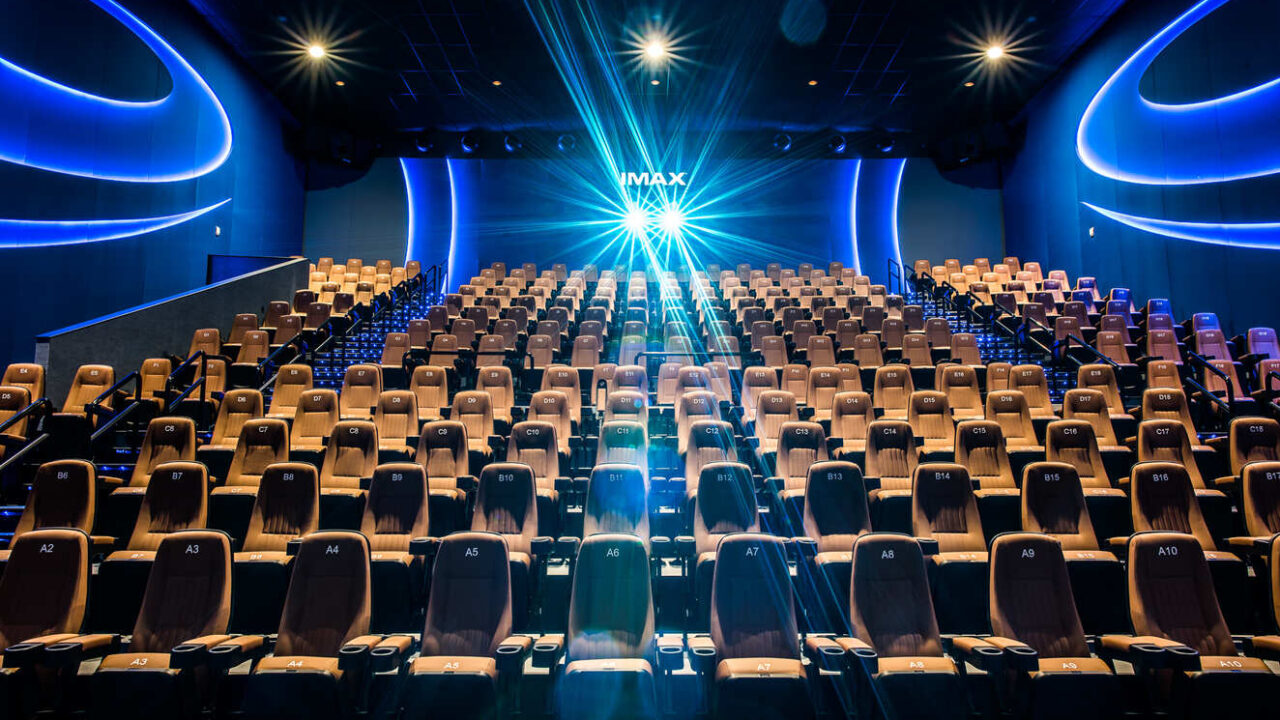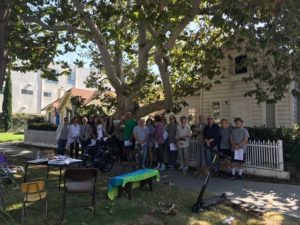Gentrification’s Theater of Dreams
Can historically Black L.A. neighborhoods have development without displacement? This summer, cinema returned to Inglewood, Calif. Courtesy of Cineopolis.
This summer, cinema returned to Inglewood, Calif. Courtesy of Cineopolis.
I was stunned: In July, a top-of-the-line cinema with IMAX screens and in-theater dining opened in Inglewood, the historically Black city that sits between South Central and the more affluent beach cities of South Bay. In a community whose movie theaters were all shuttered or repurposed decades ago, the appearance of Cineopolis, an international chain, was good news. I needed some. As a longtime Inglewood resident, I’ve watched a recent escalation in development with an increasingly wary eye. In less than a decade, a number of projects — SoFi stadium, home to the Los Angeles Rams and Chargers and the biggest stadium in the NFL, a glammed-up casino, luxe apartments, single family homes, hotels, retail — fit a familiar pattern of gentrification in which they will inevitably displace the longtime residents they claim to serve. In Inglewood, each new construction site only seemed to add more upward pressure on rents and home prices that have risen astronomically since the mid-2010s.
The debut of Cineopolis momentarily disrupted my pessimism. I grew up in South Central and have lived in and around Inglewood much of my life, but I’d never had a place like it within walking distance. This particular development seemed magical, reminiscent of the ubiquitous L.A. movie palaces of my youth. On my first trip to the theater, I encountered another surprise. On the breezeway leading to the multiplex were Black faces on huge signs promoting the 300-acre mixed-use development known as Hollywood Park and the wider development of Inglewood. There were plenty of white faces on the signs, too, but the prominence of people of color suggested that the whole endeavor of building a “new” Inglewood was for their benefit. The Black folk picture above the evolving city’s new slogans — Local Authenticity. Global Stage — looked happy, prosperous, very much at home.
My first response was to take offense. As development public relations went, it was pretty crude: recasting disruptive and breakneck development as the “authentic” growth that Black people have always wanted and deserved. And yet, despite my anger at the corporate pretense of caring about the communities being upended, part of me agreed with what I was seeing. Black people should be on the billboards; they should be prospering from changes happening in their midst. Yes, the advertisements were manipulative and more than a little exploitative, but that couldn’t wholly dim my satisfaction in seeing Black folks so elevated. The ads were encouraging residents like me to indulge in a fantasy of gentrification without displacement. Admittedly, I did, but with eyes wide open.
I started reporting in 1992, in the aftermath of the civil unrest that burned whole swaths of L.A.’s commercial corridors and left many neighborhoods of color, including Inglewood, even more fallow than they’d been. At the time, there was much talk about rebuilding and what the community wanted — restaurants, shops, office space, mixed-use buildings, jobs. Little of it materialized. In 1996, Lakers legend Magic Johnson opened a movie theater complex at the Crenshaw Baldwin Hills Plaza. It wasn’t luxe, but the arrival of a new theater — a new anything — was hailed as a very big deal. Johnson’s theater anchored hopes for more and better projects, for a new era of Black agency in development. Then the economy tightened, the wealth gap opened further and Black and brown neighborhoods were left to fend for themselves.
In Inglewood, each new construction site only seemed to add more upward pressure on rents and home prices that have risen astronomically since the mid-2010s.
The mid-aughts brought the first signs of gentrification, which only accelerated following the Great Recession. With this shift came an interest in developing Inglewood and South Central that Black people had been unable to command for decades. Neighborhoods once considered flyover zones became rebranded as “USC-adjacent,” their historic bungalows and Craftsman-style homes snapped up at bargain prices by white people increasingly unable to afford homes in west L.A. and the San Fernando Valley. South Central, the Crenshaw district and then Inglewood, places once hollowed out by white flight, were recast by real estate agents and speculators as hip destinations that had lots of what those in the property business call “potential.”
I was alarmed by this shift, as were most of my Inglewood neighbors. We saw the forces of gentrification as a threat to our community’s well-being every bit as dangerous as gangs and drugs. At the same time, we continued to harbor dreams of good development and Black agency — dreams that were improbably stirred within me by the billboards outside Cineoplis.
Other things stirred me. On my stroll to the theater that day, I passed two works of public art: a wall mural with the message “The Difference is Spreading,” and a pair of sculptures by renowned Black artist and L.A. native Alison Saar. More feel-good marketing meant to distract, I thought. And yet I couldn’t help but be glad to see it — Alison Saar, now also within walking distance! I allowed myself to imagine that Inglewood might yet beat the odds of history and remake gentrification in its own image; maybe we really can have development without displacement. This is the view of a local gallery owner I met not long ago, a native who absolutely believes that Inglewood, the last significantly Black city in L.A. County, will be the exception that disproves the gentrification rule. For him, the billboards are not a distraction or an exaggeration, but vindication. The people will prevail.
So-Fi Stadium, which began construction in 2015, was on the verge of opening when George Floyd happened in the spring of 2020. This presented the city a good opportunity to reaffirm its promise that the billion-dollar project was not just another fortress-like stadium located in a downscale neighborhood with minimal connection to the surrounding community (as was the case with Inglewood and the Forum during the 40 years the Lakers lived there). City officials, developers and architects painted the stadium as a genuine boon to longtime residents, one that would gift them a lake, surrounding green space and other amenities that added value to neighborhoods. Best of all, So-Fi would anchor a grand oasis of wider redevelopment in process.
But with the average cost of housing and rent in Inglewood rising even faster than most other L.A. neighborhoods, it remains unclear how many Black people will be around to enjoy the fruits of all this. The grassroots coalition Uplift Inglewood has been agitating for affordable housing and working to protect public land from the private developers who keep coming at the city like fastballs. The pressure has worked in some ways, not so much in others. The city passed anti-rent increase ordinances in 2019, but then gave land away to the L.A. Clippers basketball team for their new Intuit Dome, which is going up across the street from Hollywood Park. As part of the deal, Clippers owner Steve Ballmer pledged $100 million to the city, mostly to aid affordable housing development. If that doesn’t sound like nearly enough, it isn’t.
But for development advocates (they are loath to call themselves “gentrification advocates”) these are minor details. Inglewood mayor James Butts is fond of saying that the only thing changing in Inglewood is “everything”. He touts SoFi stadium as a “genesis device” — Star Trek lingo for a technology that turns uninhabitable planets habitable. This sounds lofty, and more than a little insulting, but his vision builds on that of the previous mayor, Roosevelt Dorn, who described the flurry of chain stores and restaurants that relocated here in the ’90s and aughts —Costco, Red Lobster, the GAP— as “Inglewood on the Move.” That suburban-minded development wasn’t fancy, but it collectively bolstered Inglewood’s middle-class profile and laid the groundwork for far more ambitious redevelopment at Hollywood Park now being hailed as a full-on “Renaissance.” Christopher Meany, a partner at Wilson Meany, Hollywood Park’s development manager, described the city’s “real superpower” to L.A. Business Journal as “the incredible cosmopolitan community that surrounds it. This is the one part of L.A. that didn’t have that social retail heart. Our project is about creating that.”
With the average cost of housing and rent in Inglewood rising even faster than most other L.A. neighborhoods, it remains unclear how many Black people will be around to enjoy the fruits of all this.
Hard to believe now, but Inglewood once made national headlines for resisting development hype. In 2004, Walmart, the world’s biggest retailer, proposed a supercenter on the Hollywood Park property owned by L.A. Rams owner Stan Kroenke. The company expected a cakewalk, but Inglewood city officials, concerned about the negative impact on locals, balked. Voters next soundly rejected the plan at the ballot box. That now feels like several political eras ago. Officials approved the SoFi stadium at warp speed, and this time around, voters had no say on the project, which was approved without an environmental impact report and no public hearings. From the start, the message from officials has been almost gospel: The new stadium will finally put Inglewood over the top, assert its greatness, and — a more subtle message, but crucial — give Black people the due that has proven so elusive since ’92.
Even if one believes that, claims by corporations that they are committed to improving Black lives are, at best, ahistorical, as is the idea that gentrification is motivated by Black improvement, not white reclamation. Back in the early 2000s, Kenneth Moore ran a jazz coffeehouse called Howling Monk in downtown Inglewood, which closed after the promised improvements to the area never came. Two decades after Moore’s business lost out to the political influence wielded by Costco and the GAP, he uses the word “bamboozle” to describe the pro-community campaign being peddled by much bigger players. “It’s the open conspiracy of Black displacement that’s been going on forever,” he says.
He adds that truly improving Inglewood would entail things like supporting the struggling school district. That would be real wealth-building, an improvement worth advertising on billboards. Schools and housing are the foundation of any place; everything else is shiny objects, a boon for the people who build them. And yet, Moore still says he’d love to be downtown now, among the new coffeehouses and galleries that operate in the shadow of the high-rises, one of which recently mounted a show of his artwork. “It would have been great if I could have hung on another 27 years,” he says, with a mix of sarcasm, exasperation and wistfulness that I understand completely.
Moore’s struggle to maintain his ideals contrasts with the bottom-line philosophy of a friend of mine, a veteran of street-level politics who likes to say that in Black communities forced to fight for basic amenities, anything is better than a hole in the ground. She isn’t being cynical, just practical. It’s just what happens. But it’s a view that too often concedes power to outsiders, precluding the possibility of community agency. The billboards, calculated as they are, send the aspirational message that Black empowerment should and can drive development. It’s a message Black people in Inglewood and elsewhere need to see, writ as large as possible. Because believing this message — even if we can’t trust the messenger — is what matters. That belief is better than a hole in the ground. And, I will say, so is a Cineopolis.
Your support is crucial…With an uncertain future and a new administration casting doubt on press freedoms, the danger is clear: The truth is at risk.
Now is the time to give. Your tax-deductible support allows us to dig deeper, delivering fearless investigative reporting and analysis that exposes what’s really happening — without compromise.
Stand with our courageous journalists. Donate today to protect a free press, uphold democracy and unearth untold stories.






You need to be a supporter to comment.
There are currently no responses to this article.
Be the first to respond.